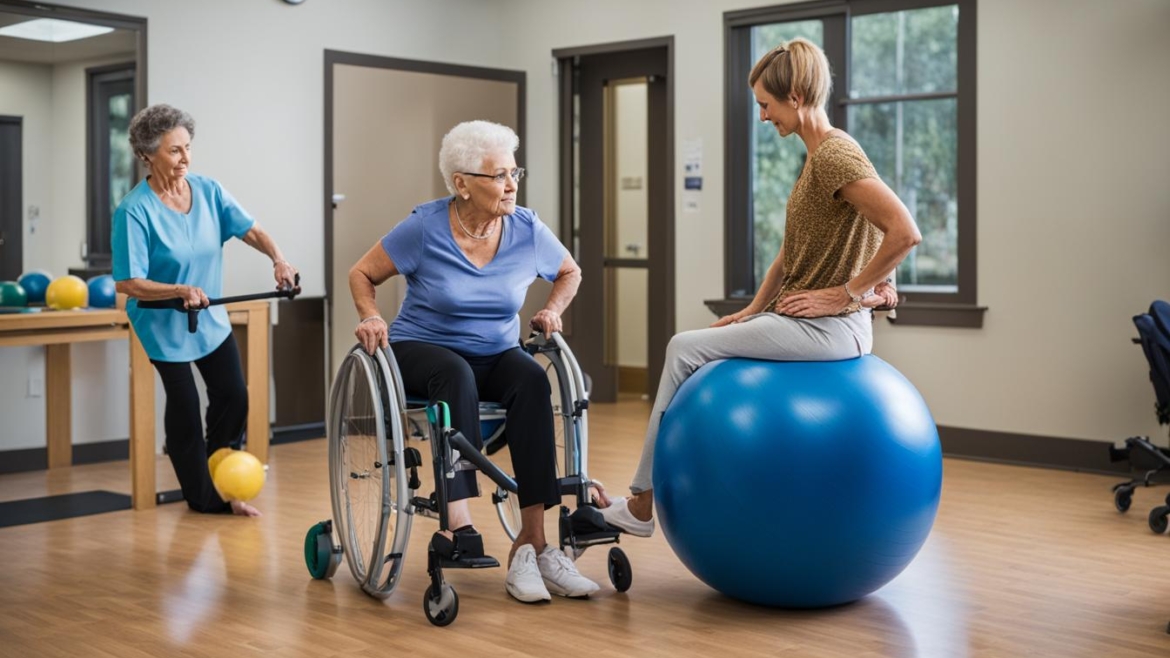Balancing Treatment: How Occupational Therapy Differs from Physical Therapy in Patient Care
When navigating the landscape of rehabilitative care, it’s essential to grasp the differences between occupational therapy and physical therapy, as both play pivotal roles in helping individuals recover and maintain their quality of life. While they share common goals of improving patients’ well-being, the paths they take are distinct. Here in our collective journey, we’ll uncover these differences and the unique benefits of occupational therapy alongside the benefits of physical therapy. Understanding the nuances of each can empower us and our loved ones to make informed decisions about the type of care that will best support each individual’s recovery and daily living.
Key Takeaways
- Understanding how occupational therapy enriches daily life with specialized techniques.
- Physical therapy’s emphasis on improving mobility and pain management strategies.
- Distinguishing the treatment approaches to better decide on the care needed.
- The significant, yet varying roles both therapies play in rehabilitation.
- Unveiling the potential for a collaborative approach in therapy to maximize patient outcomes.
Exploring the Core Philosophies of Occupational and Physical Therapies
As we dive into the world of rehabilitation, it’s essential to understand the distinct core philosophies that influence occupational therapy techniques and physical therapy techniques. Both fields strive for excellence in patient care, but they do so from different angles and with unique tools at their disposal. Let’s shed some light on these philosophies and how they manifest in both occupational therapy treatments and physical therapy treatments.
Occupational therapy focuses on improving a patient’s ability to perform daily activities through therapeutic engagement. The idea is that the therapy should revolve around not only physical well-being but also the emotional and social aspects of rehabilitation. It’s about equipping patients with the skillsets required to navigate their regular routines and environments effectively.
Occupational therapy empowers individuals to live life to its fullest—no matter what hurdles they may face. It’s more than a treatment; it’s a journey to independence.
On the other hand, physical therapy primarily emphasizes enhancing movement, reducing pain, and restoring physical function following an injury or illness. It’s about teaching the body to move efficiently and painlessly to ensure a high quality of life.
- Improving joint and muscle function through targeted exercises.
- Encouraging mobility and stability in patients recovering from surgery or injury.
- Utilizing hands-on techniques, like manual therapy, to aid in recovery.
The common goal may be to enhance the patient’s quality of life, but the approaches and objectives set by each field dictate the techniques and treatments used. As we explore these realms, we discover that the journey through either occupational or physical therapy is as nuanced as the individuals who walk their paths.
The Unique Objectives of Occupational Therapy


Occupational therapy boasts an array of benefits that address the comprehensive needs of various patient populations. Part of understanding the benefits of occupational therapy lies in recognizing the specific objectives that practitioners aim to achieve. These goals are not merely about delivering care but about empowering individuals to lead productive and satisfying lives.
Let’s discuss the occupational therapy job description and the objectives that guide occupational therapists in their practice:
- Developing and enhancing skills for daily living to promote independence in patients
- Improving cognitive function and fostering better coping mechanisms for behavioral health
- Facilitating hand-eye coordination to enable participation in work, play, or educational activities
- Assessing and modifying environments, both at home and work, to improve accessibility and functionality
- Collaborating with patients to tailor intervention plans that align with their personal goals and circumstances
- Analyzing and addressing physical challenges to improve safety and ease of performing tasks
The core of occupational therapy centers on adapting to the needs of the patient. Therefore, one of our main priorities includes:
Creating individualized treatment strategies that enable patients to reach their fullest potential in carrying out day-to-day activities.
This includes assessing patients’ environments and recommending changes to support better living conditions. Occupational therapists also educate patients and their families on methods to continue therapies at home, ensuring that every aspect of care is addressed.
In practice, here’s a look at some of the key areas occupational therapists focus on:
| Objective | Action | Expected Outcome |
|---|---|---|
| Motor Skills Improvement | Utilize exercises to increase dexterity | Enhanced ability to complete everyday tasks |
| Cognitive Skills Enhancement | Employ memory and problem-solving activities | Improved coping strategies and job performance |
| Sensory Processing Support | Introduce sensory-integrative techniques | Decreased hypersensitivity and better focus |
| Adaptive Techniques Training | Teach use of assistive devices | Greater independence in personal care and mobility |
Through these objectives, occupational therapy fulfills a unique role in patient care, moving beyond traditional medical treatments to support overall well-being. Its intent to bolster everyday functionality promotes a higher quality of life for patients spanning all age groups and various conditions.
Key Goals and Outcomes of Physical Therapy
Embarking on a journey with physical therapy, we aim to unlock the full benefits of physical therapy, attuning to the physical therapy job description that emphasizes functional recuperation and pain management. Let’s dive deep into the core objectives that make this therapeutic approach instrumental to patient rehabilitation.
Improving Mobility and Physical Function
At the heart of our mission is the desire to improve mobility. The success of physical therapy is often manifested through the enhancement of patients’ physical functions, allowing for a return to daily activities with ease. Techniques such as stretching, strengthening exercises, and endurance training play pivotal roles.
Physical Therapy Techniques for Pain Management
Another cornerstone of physical therapy is effective pain management. Employing a gamut of techniques ranging from manual therapy to modalities like heat, ice, and ultrasound, therapists design personalized pain relief plans aligning with each patient’s unique needs.
Measuring Success in Physical Therapy
We gauge the success of physical therapy by tracking progress towards personal goals set at the beginning of the therapy. Functional improvements, pain reduction, and the ability to perform specific tasks are benchmarks of successful intervention.
Understanding that every patient’s journey is distinct, the table below paints a picture of the standard measures we often use to track a patient’s progress:
| Outcome Measures | Description | Relevance |
|---|---|---|
| Ranges of Motion (ROM) | Assessment of joint flexibility and movement extent | Indicates progress in mobility |
| Pain Scale Rating | Subjective scoring of pain levels | Helps in tuning pain management strategies |
| Functional Movement Scale | Evaluation of basic movements inherent to daily tasks | Provides insights into functional gains |
| Therapeutic Milestones | Targeted objectives such as walking a certain distance | Reflects practical achievements in therapy |
It’s through these targeted approaches that we aim to yield the most impactful results for our patients, fulfilling the broad promise held within a physical therapist’s role.
Occupational Therapy Techniques in Action


In our collective journey to shed light on the efficacy of occupational therapy techniques, we often encounter remarkable stories of resilience and recovery. These interventions are more than just treatments; they are pathways to independence and empowerment. Let’s delve into the array of occupational therapy treatments and understand how they transform lives.
Adaptive equipment, for instance, is a cornerstone of occupational therapy. These devices are tailored to assist individuals in performing daily tasks, overcoming the limitations imposed by their conditions. From ergonomic utensils for those with grip difficulties to computer aids for enhanced communication, each piece of equipment plays a vital role in rehabilitating patients.
Furthermore, cognitive-behavioral strategies employed in occupational therapy focus on the mind’s power to influence behavior and emotional well-being. These techniques help patients develop coping mechanisms for stress, modify harmful patterns of thinking, and adapt to their environment with greater ease.
| Technique | Application | Outcome |
|---|---|---|
| Sensory Integration | Used to help individuals process and react to sensory information in an appropriate manner. | Improved focus and reduced anxiety, especially in individuals with sensory processing disorders. |
| Environmental Modification | Adapting physical spaces to ensure accessibility and safety for the patient. | Increased independence in navigating and utilizing personal and public spaces. |
| Therapeutic Exercise | Custom exercises to enhance motor skills and physical endurance. | Enhanced ability to perform daily activities and improved gross motor function. |
| Activity Modification | Adjusting the difficulty or approach to activities to match the patient’s capabilities. | Greater engagement and success in daily and recreational activities. |
Each technique is a testament to the ingenuity and personalized care inherent in occupational therapy treatments. It’s through the meticulous application of these techniques that patients reclaim their ability to function and find joy in the everyday.
As we continue to explore these transformative therapies, it’s worth noting the emotional and psychological impact they have. Beyond physical rehabilitation, occupational therapy fosters confidence and adaptability, which resonate through every aspect of a patient’s life. It is not just a service; it is a journey towards holistic well-being.
Physical Therapy Treatments: Procedures for Recovery
As leaders in the field of rehabilitation, we’ve seen firsthand the transformative power of physical therapy treatments. Each technique and procedure is a critical piece in the puzzle of recovery, often restoring not just function, but also independence and quality of life. Let’s delve into the fabric of these treatments, understanding how they’re thoughtfully pieced together to awaken the body’s innate healing processes.
The Role of Exercise in Physical Therapy
Exercise isn’t just about building muscle; in physical therapy, it’s a therapeutic cornerstone. Tailored exercises are designed to regain lost function, enhance strength, improve flexibility, and even mitigate pain. From basic stretches to advanced resistance training, each movement targets specific recovery goals forged by our detailed assessments.
Advanced Physical Therapy Modalities
Now, let’s highlight some of the advanced techniques in our therapeutic arsenal. Ultrasound therapy leverages sound waves to promote deep tissue healing, a process both gentle and effective. Electric stimulation, another modern marvel, uses controlled electrical impulses to alleviate pain and facilitate muscle function. These state-of-the-art modalities are selected to complement the physical therapy techniques that form the foundation of our treatment plans.
Customizing Physical Therapy Programs for Patients
To ensure our physical therapy treatments are as effective as possible, we emphasize customization. Recognizing the uniqueness of each recovery journey, our treatment plans are as varied as our patients themselves. By integrating patient history, current physical assessments, and long-term goals, our bespoke programs harness the full spectrum of our techniques, moving patients from where they are to where they aspire to be — fully recovered.
Understanding the Occupational Therapy Job Description


Delving into the realm of occupational therapy, we often find ourselves enamored by the broad scope of practice that this profession encompasses. As we shine a light on the occupational therapy job description, it becomes clear that a tapestry of skills, settings, and specializations awaits those interested in this dynamic field. Here, we unpack the essentials that define the role of an occupational therapist.
Skills Required for Occupational Therapists
Occupational therapists bring a unique set of skills to their practice. From nuanced communication and critical thinking to the fine-tuned motor skills required for daily patient care, these professionals embody a blend of compassion and technical proficiency. Among the core competencies, they must excel in patient assessment, developing individualized treatment plans, and employing evidence-based therapy interventions that cater to a person’s specific needs.
Various Settings Where Occupational Therapists Work
Occupational therapists are not confined to a single workspace; their expertise is sought in diverse environments. From hospitals and rehabilitation centers to schools and private practices, OTs play pivotal roles. They may even venture into community settings or engage in home health services, adapting each space to facilitate patients’ therapeutic journeys toward greater independence and quality of life.
Occupational Therapy Specializations
Within occupational therapy, there are numerous specializations that practitioners can pursue, each requiring its distinct blend of knowledge and skills. Some may specialize in pediatrics, assisting children to reach developmental milestones, while others might focus on gerontology, aiding older adults to navigate the challenges of aging. From hand therapy to mental health rehabilitation, each specialization offers the opportunity to transform lives in tailored, meaningful ways.
The Comprehensive Physical Therapy Job Description
When we talk about a physical therapy job description, we’re referring to not just a list of tasks, but a profile that encompasses a myriad of skills, responsibilities, and the profound impact these professionals have on their patients’ lives. Physical therapists (PTs) are instrumental in the rehabilitation and treatment of patients with a wide variety of injuries and conditions. Their work is fundamental in helping individuals regain movement and manage pain, thus significantly improving their quality of life.
In our discussions with industry professionals, we’ve come to understand that the job of a physical therapist is both demanding and fulfilling. It requires a solid foundation in knowledge, a set of refined interpersonal skills, and a passion for continuous learning. Let’s dive into a detailed look at the key components that make up the rewarding career of a physical therapist.
| Educational Qualifications | Core Skills | Typical Responsibilities | Work Environments |
|---|---|---|---|
| Doctor of Physical Therapy (DPT) degree | Strong analytical skills | Assessing patient needs | Hospitals |
| State licensure | Empathy and compassion | Creating treatment plans | Outpatient clinics |
| Continuing education for specialization | Physical endurance | Implementing therapeutic exercises | Private practices |
| Residency or fellowship (optional) | Communication skills | Educating patients and families | Sports facilities |
Physical therapists often find themselves wearing multiple hats throughout their day. Whether they’re collaborating with other healthcare professionals to provide comprehensive care or researching the latest in rehabilitative technologies, their job is never monotonous. And this flexibility is crucial, as they adapt their approach to cater to each patient’s unique needs.
As we perfect our craft in the evolving landscape of healthcare, physical therapists demonstrate an unwavering commitment to improving patient outcomes. They assess patient progress meticulously, ensuring that each step taken is a stride towards recovery and independence.
One seasoned PT shared with us, “The most rewarding part of our job is seeing a patient take that first step after an injury or surgery. Knowing you played a part in that process is incredibly fulfilling.”
Indeed, the physical therapy job description is extensive and diverse. It is a career that offers the opportunity to make a meaningful difference in people’s lives daily, embodying a perfect blend of science, care, and innovation.
Who Benefits Most from Occupational Therapy?
As we look at the spectrum of care, it’s evident that the benefits of occupational therapy touch various groups, offering vital support and enhancing quality of life. We’re going to explore how occupational therapy treatments specifically cater to different needs across age groups and abilities, painting a vivid portrait of its impact.
Occupational Therapy in Pediatric Care
Children facing developmental challenges find a strong ally in occupational therapy. Tailored strategies help them master everyday tasks, gaining self-confidence and autonomy. Therapists work on fine motor skills, sensory integration, and social interaction, laying a foundation for a more adaptive childhood experience.
Helping the Elderly Maintain Independence
Helping seniors maintain their independence is another cornerstone of occupational therapy, where the focus is on aging gracefully. Interventions may include home modifications, fall prevention, and cognitive exercises, empowering the elderly to enjoy a safer, more engaged lifestyle.
Support for Individuals with Disabilities
For individuals with disabilities, occupational therapists devise comprehensive plans to navigate life’s challenges. Whether it’s finding new ways to perform tasks or utilizing adaptive equipment, occupational therapy treatments make a tangible difference, enabling clients to lead fuller, more independent lives.
The Ideal Candidates for Physical Therapy
When we talk about the benefits of physical therapy, we’re looking at a treatment approach uniquely tailored to individuals facing a wide array of physical challenges. The ideal candidates for physical therapy are those who seek relief, recovery, and a return to peak physical function. Let’s shed some light on the profiles of patients who would find substantial value in the myriad of physical therapy techniques available.
Whether it’s recovering from an injury or managing chronic pain, physical therapy offers a non-invasive path to healing and rehabilitation. Candidates typically include:
- Those who have undergone surgery and are on the road to recovery
- Individuals with sports-related injuries looking to regain full mobility
- People suffering from chronic back, neck, or joint pain
- Patients with neurological conditions seeking to improve balance and motor functions
- Individuals with arthritis looking for strategies to manage pain and maintain functionality
| Condition Categories | Physical Therapy Benefits | Common Techniques Used |
|---|---|---|
| Post-surgical Recovery | Reduced recovery time, improved healing | Scar tissue management, strength training |
| Sports Injuries | Regained strength and mobility, reduced risk of re-injury | Stretching exercises, sports-specific training |
| Chronic Pain Management | Alleviated pain, enhanced quality of life | Manual therapy, therapeutic exercises |
| Neurological Rehabilitation | Improved balance, better control of movements | Gait training, balance exercises |
| Arthritis Management | Maintenance of joint function, pain reduction | Hydrotherapy, low-impact strengthening |
Physical therapy is not just a remedial approach but a transformative journey for many. If you or someone you know fits these profiles and is battling physical limitations, reaching out to a licensed physical therapist could mark the beginning of a highly rewarding path to improved wellbeing. Remember, embarking on physical therapy is a proactive step toward reclaiming the joy of movement and the independence that comes with it.
Tools and Equipment Used in Occupational Therapy


In our exploration of occupational therapy techniques, it becomes evident that the tools and equipment used are integral to providing effective occupational therapy treatments. These devices range from simple adaptive equipment, designed to assist with daily living activities, to sophisticated sensory integration tools that facilitate complex therapeutic interventions. We will now delve into a selection of these tools, shedding light on their purpose within the therapeutic process.
- Adaptive Tools for Activities of Daily Living (ADLs)
- Sensory Integration Equipment
- Assistive Technology Devices
- Therapeutic Exercise Equipment
Each category of tools carries its significance and application, allowing occupational therapists to tailor their approach to the individual needs of their patients. Here’s a closer look:
| Category | Examples | Function |
|---|---|---|
| Adaptive Tools | Button hooks, extended reachers | Facilitates independence in dressing and reaching |
| Sensory Integration | Weighted blankets, therapy swings | Provides proprioceptive input for sensory regulation |
| Assistive Technology | Communication devices, electronic aids | Enhances communication and interaction |
| Therapeutic Exercise | Resistance bands, balance boards | Improves strength, balance, and coordination |
The selected tools and equipment play a pivotal role in achieving therapeutic goals, enabling patients to work on improving their functional abilities and overall quality of life. Investing in the right tools is essential for therapy to be as effective and personalized as possible.
Sensory integration tools, for example, are not just about the physical aspects but also carry importance for cognitive and sensory-motor development. By stimulating various senses, these tools can help individuals better process and respond to sensory information, which is crucial for those with sensory processing disorders.
Ultimately, the tools and techniques we apply in occupational therapy are diverse and tailored, built upon a solid understanding of each patient’s unique requirements. As we utilize these various instruments, we weave together a tape for rehabilitation that supports, empowers, and facilitates our patients as they journey towards a more independent life.
Innovative Physical Therapy Technology and Resources
As we delve deeper into the realm of physical rehabilitation, we encounter groundbreaking advancements that refine and enhance physical therapy techniques and treatments. Our commitment to staying at the forefront of innovation ensures that the resources we employ not only aid in recovery but also transform patient experiences.
Emerging Trends in Physical Rehabilitative Devices
The proliferation of cutting-edge devices in physical therapy is transforming the landscape of patient treatment. From wearables that track movement to robotics that aid in strength training, these technologies are ensuring more precise and effective interventions. The integration of such devices is pivotal for advancing care and optimizing outcomes.
Using Virtual Reality for Enhanced Physical Therapy
Virtual reality (VR) has transcended the boundaries of entertainment to emerge as a valuable tool in physical therapy treatments. By immersing patients in a controlled and interactive environment, VR facilitates not only the simulation of real-life activities essential for recovery but also provides a motivational landscape for patients to engage in their treatment process.
Importance of Patient Education in Physical Therapy
The adage ‘knowledge is power’ holds particularly true in the context of physical therapy. Educating patients about their treatments, the expected progress, and how to maintain improvements can dramatically impact their recovery journey. This empowerment through education is paramount for sustained success post-therapy.
| Trend | Application in Physical Therapy | Benefits |
|---|---|---|
| Wearable Technology | Monitoring and feedback on patient’s movements and progress | Real-time data, personalized treatment adjustments |
| Robotic Assistance | Support and enhancement of mobility training | Greater precision, reduced physical strain on therapists |
| VR Interventions | Simulation of real-world environments for safe practice | Enhanced engagement, accelerated recovery |
| Patient-Centered Apps | Access to care plans, educational materials, and progress tracking | Increased involvement in treatment, better adherence to programs |
Integrating Occupational and Physical Therapies for Holistic Care
When we talk about providing comprehensive patient care, the correlation between occupational therapy vs. physical therapy becomes significant. While each discipline has distinct goals, integrating both can amplify the benefits of occupational therapy and the benefits of physical therapy. This harmonious approach can lead to a more rounded treatment plan, addressing a spectrum of patient needs from physical abilities to daily functionalities.
We understand that for a patient recovering from an injury or adapting to a new way of life, the line between physical capabilities and everyday activities is often blurred. For example, a stroke patient may require the strength and mobility work of physical therapy, but also the adaptive techniques and life skills training that occupational therapy provides.
Let’s see how health professionals can weave these therapies together to give patients a robust support system that encourages a seamless return to their daily lives.
| Aspects | Occupational Therapy Integration | Physical Therapy Integration |
|---|---|---|
| Objective | Promotes independence in daily living | Improves strength and mobility |
| Techniques | Adaptive equipment training | Exercise and pain management |
| Outcomes | Enhances quality of life | Restores physical function |
| Patient Engagement | Focuses on meaningful activities | Targets functional ability and movement |
| Calibration | Adjusts approach based on patient’s lifestyle | Calibrates based on physical progress |
We can see the synergy that emerges when occupational therapists and physical therapists collaborate. They gain a more profound understanding of their patients’ journeys, allowing for treatments that polish physical abilities while also fortifying the skills needed for everyday life.
Ultimately, as we navigate the unique paths of our patients’ recovery, our objective is to blend the benefits of occupational therapy with the benefits of physical therapy into a cohesive treatment panorama that respects both the human spirit and the physical body. Our role as healthcare providers is not just to repair, but to inspire and empower complete wellness.
Occupational Therapy vs. Physical Therapy
In the world of rehabilitative care, it is pivotal for us to discern the differences between occupational therapy and physical therapy. Although these disciplines intersect at the street corner of patient wellness, they reside in unique buildings of practice. Our journey in understanding their distinct routes will illuminate the specific circumstances under which each one thrives and the instances where they join forces for the greater good of patient health.
Distinguishing the Treatment Approaches
Occupational therapy orbits the everyday life of patients, homing in on enhancing their ability to perform daily tasks and activities. It’s tailor-made to dress the needs of individuals struggling with physical, mental, or cognitive impairments, by not just treating the condition but by also teaching skills that strap wings to one’s independence. Physical therapy, on the other hand, focuses on the physical recuperation of patients, rehabilitating movement and easing pain caused by injuries or chronic conditions. This therapy pumps the heart of one’s physical potential so that it beats to the rhythm of an improved quality of life.
Interdisciplinary Cooperation Between Therapists
The magic happens when occupational and physical therapists lock arms in interdisciplinary cooperation. By interweaving the strengths of both specialties, a robust tapestry of care is woven, providing a comprehensive treatment plan that bridges the gaps of healthcare. This synergy fosters a collaborative environment where knowledge is shared, and patient care is amplified through a multi-faceted lens. In the quest to provide holistic care, this blending of expertise is nothing short of crucial.
Case Studies: When to Apply Each Therapy
To further muddy the clear waters of understanding, let’s dip into case studies that sharpen our view of when to apply each therapy. Consider a stroke survivor: occupational therapy empowers them to rekindle their relationship with daily activities, whereas physical therapy rebuilds the foundation of their physical abilities. Another vignette features a sports injury, wherein physical therapy initially takes center stage to restore function, while occupational therapy later ushers in a smooth transition back to the athlete’s daily life and career. These real-world scenarios stamp our passports with the knowledge of appropriating each therapy to where it is most needed, rounding out our expedition across the landscape of patient care.
FAQ
What are the main differences between occupational therapy and physical therapy?
Occupational therapy focuses on improving a patient’s ability to perform daily activities through specialized treatments, while physical therapy concentrates on improving physical function, mobility, and managing pain.
What are some common techniques used in occupational therapy?
Techniques in occupational therapy include activity modification, assistive device training, sensory integration, cognitive behavioral therapy, and environmental adaptation to meet clients’ individual needs.
Can you describe some physical therapy treatments?
Physical therapy treatments often involve exercises to improve strength and mobility, manual therapy techniques, pain management strategies like heat or cold therapy, and the use of advanced modalities such as ultrasound and TENS.
What is the primary objective of occupational therapy?
The primary objective of occupational therapy is to empower patients to participate fully in the activities of everyday life by enhancing their skills, modifying their environment, or using adaptive equipment.
What are the key goals of physical therapy?
The key goals of physical therapy are to alleviate pain, restore physical function, improve mobility, enhance strength, and prevent or recover from injury.
What skills are required for occupational therapists?
Skills required for occupational therapists include a strong understanding of medical conditions, excellent communication and problem-solving skills, creativity, patience, and empathy.
In what settings do physical therapists typically work?
Physical therapists work in a variety of settings, including hospitals, outpatient clinics, rehabilitation centers, skilled nursing facilities, schools, sports facilities, and home health agencies.
Who benefits most from occupational therapy?
People of all ages who are experiencing physical, cognitive, or mental health challenges that affect their daily living and work skills benefit immensely from occupational therapy, including children, the elderly, and individuals with disabilities.
What tools and equipment are commonly used in occupational therapy?
Occupational therapists use a range of tools and equipment, such as adaptive utensils for eating, writing aids, splints, sensory integration tools, and computer software that aids with cognitive functions.
What are some emerging trends in physical therapy?
Emerging trends in physical therapy include the incorporation of technology such as wearables for movement analysis, virtual reality for immersive rehabilitation experiences, and telehealth for remote patient care.
How do occupational and physical therapies integrate for holistic care?
Occupational and physical therapies often integrate for holistic care by collaboratively establishing a comprehensive treatment plan that addresses the varied aspects of a patient’s recovery, enabling a more robust and all-encompassing approach to health and well-being.
When should one choose occupational therapy over physical therapy?
One should consider choosing occupational therapy when faced with challenges completing daily tasks whether due to physical, developmental, or cognitive difficulties. It’s about enhancing quality of life and independence in daily activities.
What are some considerations when integrating occupational and physical therapy treatments?
Some considerations include the patient’s specific needs and goals, the stage of recovery, the ability to participate in therapy sessions, and the coordinated efforts of both occupational and physical therapy teams to provide complementary care.
How do therapists determine the success of physical therapy?
Success in physical therapy is measured by improvements in patient function, achievement of set goals, pain reduction, increased strength and mobility, and the overall impact on the patient’s quality of life.

